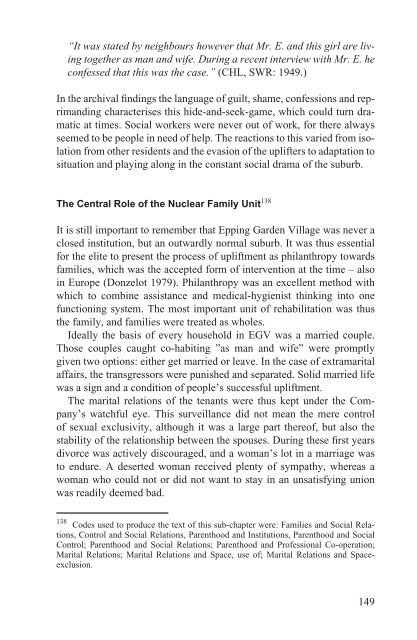The Making of a Good White - E-thesis - Helsinki.fi
The Making of a Good White - E-thesis - Helsinki.fi
The Making of a Good White - E-thesis - Helsinki.fi
Create successful ePaper yourself
Turn your PDF publications into a flip-book with our unique Google optimized e-Paper software.
“It was stated by neighbours however that Mr. E. and this girl are living<br />
together as man and wife. During a recent interview with Mr. E. he<br />
confessed that this was the case.” (CHL, SWR: 1949.)<br />
In the archival <strong>fi</strong>ndings the language <strong>of</strong> guilt, shame, confessions and reprimanding<br />
characterises this hide-and-seek-game, which could turn dramatic<br />
at times. Social workers were never out <strong>of</strong> work, for there always<br />
seemed to be people in need <strong>of</strong> help. <strong>The</strong> reactions to this varied from isolation<br />
from other residents and the evasion <strong>of</strong> the uplifters to adaptation to<br />
situation and playing along in the constant social drama <strong>of</strong> the suburb.<br />
<strong>The</strong> Central Role <strong>of</strong> the Nuclear Family Unit 138<br />
It is still important to remember that Epping Garden Village was never a<br />
closed institution, but an outwardly normal suburb. It was thus essential<br />
for the elite to present the process <strong>of</strong> upliftment as philanthropy towards<br />
families, which was the accepted form <strong>of</strong> intervention at the time – also<br />
in Europe (Donzelot 1979). Philanthropy was an excellent method with<br />
which to combine assistance and medical-hygienist thinking into one<br />
functioning system. <strong>The</strong> most important unit <strong>of</strong> rehabilitation was thus<br />
the family, and families were treated as wholes.<br />
Ideally the basis <strong>of</strong> every household in EGV was a married couple.<br />
Those couples caught co-habiting ”as man and wife” were promptly<br />
given two options: either get married or leave. In the case <strong>of</strong> extramarital<br />
affairs, the transgressors were punished and separated. Solid married life<br />
was a sign and a condition <strong>of</strong> people’s successful upliftment.<br />
<strong>The</strong> marital relations <strong>of</strong> the tenants were thus kept under the Company’s<br />
watchful eye. This surveillance did not mean the mere control<br />
<strong>of</strong> sexual exclusivity, although it was a large part there<strong>of</strong>, but also the<br />
stability <strong>of</strong> the relationship between the spouses. During these <strong>fi</strong>rst years<br />
divorce was actively discouraged, and a woman’s lot in a marriage was<br />
to endure. A deserted woman received plenty <strong>of</strong> sympathy, whereas a<br />
woman who could not or did not want to stay in an unsatisfying union<br />
was readily deemed bad.<br />
138 Codes used to produce the text <strong>of</strong> this sub-chapter were: Families and Social Relations,<br />
Control and Social Relations, Parenthood and Institutions, Parenthood and Social<br />
Control; Parenthood and Social Relations; Parenthood and Pr<strong>of</strong>essional Co-operation;<br />
Marital Relations; Marital Relations and Space, use <strong>of</strong>; Marital Relations and Spaceexclusion.<br />
149
















